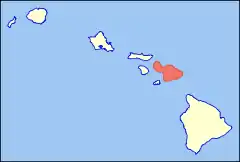King Kamehameha III's Royal Residential Complex | |
Hawaiʻi Register of Historic Places
| |
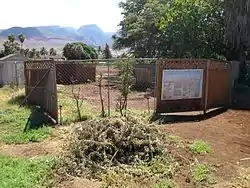 Archeological site at Mokuʻula, September 2012. | |
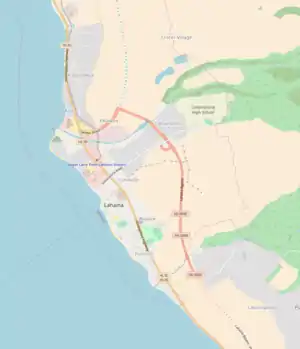 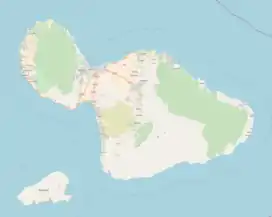 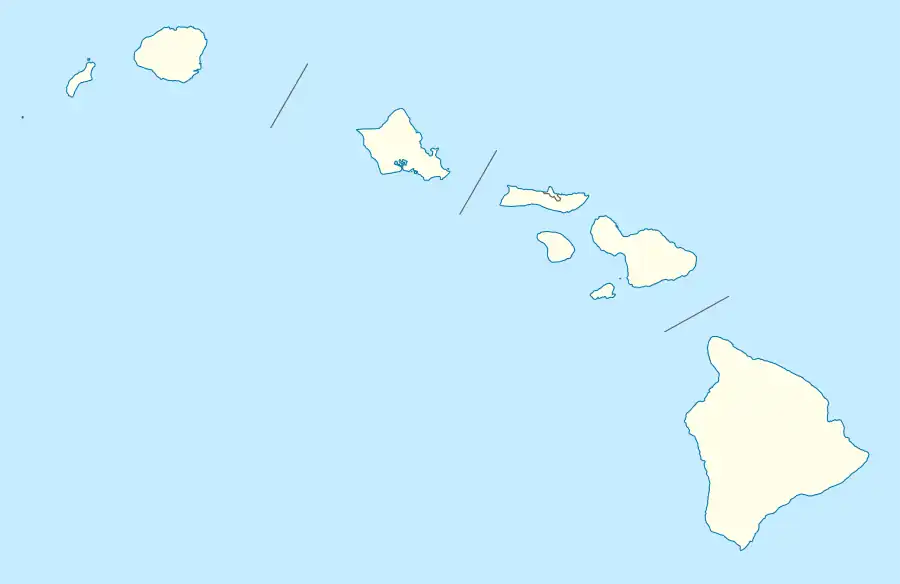 | |
| Location | Front and Shaw Streets, Maluʻulu o Lele and Kamehameha Iki Parks, Lahaina, Hawaii |
|---|---|
| Coordinates | 20°52′10″N 156°40′29″W / 20.86944°N 156.67472°W |
| Area | 12.3 acres (5.0 ha) |
| Built | 1837 |
| NRHP reference No. | 97000408[1] |
| HRHP No. | 50-50-03-02967[2] |
| Significant dates | |
| Added to NRHP | May 9, 1997 |
| Designated HRHP | May 9, 1997 |
Mokuʻula was a tiny island that has been buried beneath a baseball field in Maluʻulu o Lele Park, Lahaina, Hawaiʻi, United States. It was the private residence of King Kamehameha III from 1837 to 1845 and the burial site of several Hawaiian royals. The 1-acre (4,000 m2) island is considered sacred to many Hawaiians as a piko, or symbolic center of energy and power.[3] It was added to the Hawaiʻi State Register of Historic Places on August 29, 1994, and to the National Register of Historic Places on May 9, 1997, as King Kamehameha III's Royal Residential Complex.[4]
According to author P. Christiaan Klieger, "the moated palace of Mokuʻula...was a place of the "Sacred Red Mists," an oasis of rest and calm during the raucous, rollicking days of Pacific whaling."[5] When the capital of Hawaiʻi moved from Lahaina to Honolulu, Mokuʻula fell into disrepair. By 1919, the county turned the land into a park.[6]
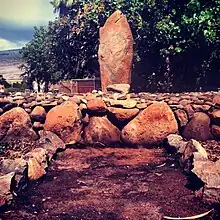
Loko o Mokuhinia
Mokuʻula was surrounded by Mokuhinia, a 17 acres (6.9 ha) spring-fed, wetland pond. The pond was reported to be the home of Kihawahine, a powerful moʻo or lizard goddess. According to myth, the moʻo was a reincarnation of Piʻilani's daughter, the chiefess, Kalaʻaiheana. Hawaiians cultivated loʻi, or taro patches, and fishponds within Mokuhinia.[7] Lahaina was once known as the Venice of the Pacific with its fishponds. The sugar cane industry dramatically diverted water from mountain streams in the late 1800s which dried up the ecosystems.[8]
Restoration
The Friends of Mokuʻula, a non-profit organization, promoted the restoration of the sacred site from 1990 to 2011.[6][9] From 1992 to 1995 and in 1999, archaeologists from Bishop Museum and Heritage Surveys surveyed the site and documented its features and boundaries.[10] Bringing water back to this site and restoring Mokuʻula and Mokuhinia received renewed attention after the devastation of the town by the wildfires in 2023.[11]
References
- ↑ "National Register Information System". National Register of Historic Places. National Park Service. April 15, 2008.
- ↑ "Historic Register Counts". Hawaii State Historic Preservation Division. State of Hawaii. February 1, 2022. Retrieved February 19, 2022.
- ↑ Becker, Nancy; Leonard Becker (1999). "Mokuʻula A Native Hawaiian Sacred Site is Being Restored". Preservation. Sacred Sites International Foundation. Archived from the original on August 7, 2008. Retrieved July 14, 2008.
- ↑ "National Register of Historic Places registration form". 1997.
- ↑ Klieger, P. Christiaan (January 2003). "Mokuʻula: The King's Island". Maui No Ka ʻOi i Magazine. Vol. 6, no. 4. Archived from the original on June 10, 2011. Retrieved August 17, 2009.
- 1 2 Kubota, Gary T. (July 10, 2003). "Group works to restore islet". Hawaiʻi News. Honolulu Star-Bulletin. Retrieved July 14, 2008.
- ↑ Schonwalter, Helen Anne (February 22, 2007). "Mokuʻula Reawakens". Features. Maui Weekly. Archived from the original on October 11, 2008. Retrieved July 14, 2008.
- ↑ Weir, Bill (August 21, 2023). "'Disaster capitalism at its finest': Fights over water amid west Maui's charred ruins ignite new fears". CNN. Retrieved August 22, 2023.
- ↑ "Friends of Moku'ula". www.mokuula.com. Retrieved September 11, 2022.
- ↑ Klieger, P. Christiaan (1995). Moku'ula History and Archaeological Excavations at the Private Palace of King Kamehameha III in Lahaina, Maui.
- ↑ Fawcett, Denby (August 22, 2023). "Denby Fawcett: Show Respect For Lahaina By Restoring Its Once Lush Wetlands". Honolulu Civil Beat. Retrieved August 22, 2023.
Further reading
- Hamilton, Chris (March 14, 2010). "In dig project, what's 'underneath' matters". Maui News.
- James, Van (2001). Ancient Sites of Maui, Molokaiʻi and Lanaʻi. Honolulu, HI: Mutual Publishing. pp. 48–52. ISBN 1-56647-529-5.
- Kamae, Eddie (Director); Wong, Kaupena (Actor) (2008). Lahaina – Waves of Change (Documentary). Hawaiian Legacy Foundation.
- Klieger, P. Christiaan (1999). Mokuʻula: Maui's Sacred Island. Bishop Museum Press. ISBN 1-58178-002-8.
- Wyban, Carol Araki (1992). Tide and Current: Fishponds of Hawaiʻi. Honolulu, HI: University of Hawaiʻi Press. ISBN 0-8248-1396-0.

